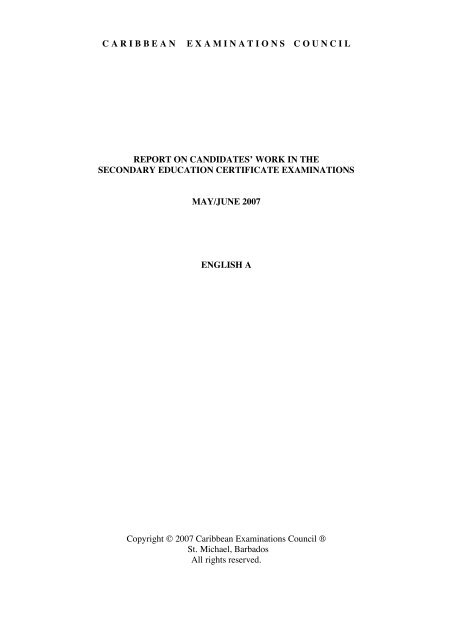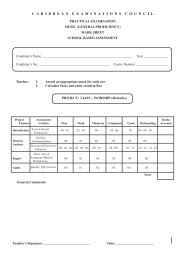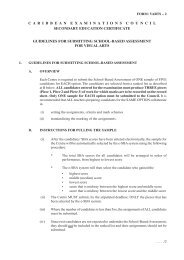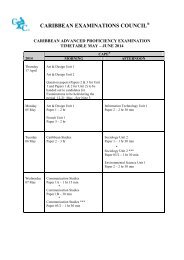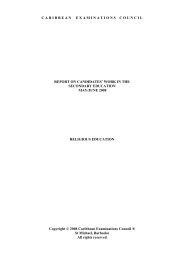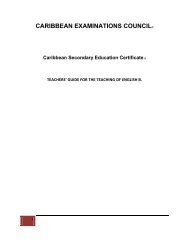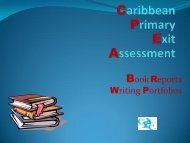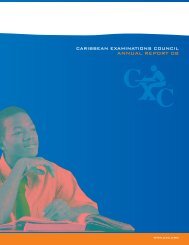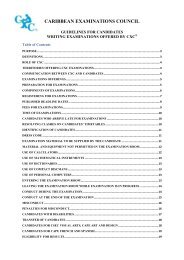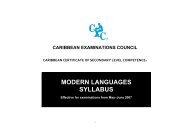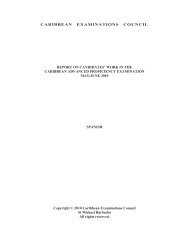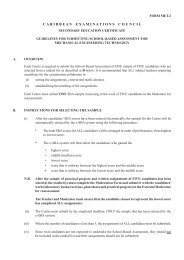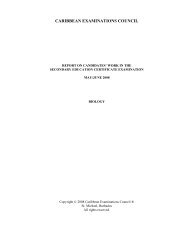English A - Caribbean Examinations Council
English A - Caribbean Examinations Council
English A - Caribbean Examinations Council
You also want an ePaper? Increase the reach of your titles
YUMPU automatically turns print PDFs into web optimized ePapers that Google loves.
C A R I B B E A NE X A M I N A T I O N S C O U N C I LREPORT ON CANDIDATES’ WORK IN THESECONDARY EDUCATION CERTIFICATE EXAMINATIONSMAY/JUNE 2007ENGLISH ACopyright © 2007 <strong>Caribbean</strong> <strong>Examinations</strong> <strong>Council</strong> ®St. Michael, BarbadosAll rights reserved.
- 3 -2003 2004 2005 2006 2007Section 1 Summary skills 8.20 9.23 8.80 10.40 (30) 10.04 (30)Section 2 Comprehension 8.22 9.30 9.16 12.58 (28) 15.45 (29)Section 3Story WritingDescription8.84 8.79 9.70 14.31 (35) 13.62 (35)10.63 (35)Section 4 Argument 9.29 8.66 10.54 13.65 (35) 13.74 (35)General adviceTeachers need to emphasise that CXC <strong>English</strong> A (both Basic and General) is an <strong>English</strong> languageexamination and that candidates are required, above all, to demonstrate competence in and control of the<strong>English</strong> language. Preparation for the examination is a gradual process of acquiring and developing skills,both passive (comprehension) and productive (expression), in the <strong>English</strong> language. In the examination,these skills must be demonstrated in all areas: the proper use of punctuation marks (not only full stops andcommas, but also the not so frequently used ones such as colons and semi-colons), as well as otherconventions in writing, such as inverted commas, upper case/lower case, abbreviations, the writing ofnumbers whether in figures or in words, correct spelling, proper sentence structure and paragraphing. Thekind of writing that has become popular in e-mail messages and text messaging is not acceptable inthis examination.Students should come to the examination with a well rehearsed procedure for tackling each question. Inaccordance with the concept of writing as a process (abbreviated under examination conditions), candidatesshould have deeply ingrained in them the procedure of identifying the topic, jotting down points, doing arough copy and producing a fair copy. This is especially important in writing a summary, in doing adescription, in writing a story and in producing a cogent argument. Teachers should advise each student,based on the student’s ability and speed, about the best way to move from a rough copy to a fair copy underCXC examination conditions.Teachers should give students specific instructions about deleting and editing so that the appearance of theirwork is not off-putting to examiners. Though examiners have to make a great effort to decipher every wordthat some candidates have written, candidates should never forget that it is their own responsibility to writelegibly.The tasks in the examination are directly related, in most cases, to real-life skills. Employers and indeed thepublic at large generally regard performance in <strong>English</strong> language examinations as a measure of one’s abilityto perform in the world of work. Consequently, it is not advantageous to treat <strong>English</strong> language as merely anacademic subject or as a subject for “nerds”.Specific advice on the sections of Paper 02In Section 1, when a summary is required, main points must be identified and organised logically within theword limit specified. In cases where the original is reproduced wholesale by the candidate, CXC markers areinstructed to interpret this as incompetence. In other words, some attempt must be made by candidates to usetheir own words. Summarising is a real-life skill (used, for example, by news reporters, policemen andCEOs reporting to their board of directors) and should be treated as such by teachers and candidates.Some candidates, in attempting to put the summary in their own words, sometimes change meanings or
- 6 -In the case of Section 4, note that argument skills require both mastery of persuasive language andpresentation of sound points, backed up by suitable examples. Providing information without using goodargumentative techniques is a weakness; so is the reverse. Candidates should pay attention to ‘tone’ and‘audience’ and not indiscriminately use the language of debating in every argument they present. Candidatescan learn different styles of argument by studying letters to the editor and editorials in newspapers as well asshort, interesting articles in popular magazines or in the magazine section of newspapers.Candidates need to read the questions carefully, make sure they understand key words, then select theirpoints, choose examples that support their points and be consistent and clear in their presentation. For someunfounded reason, some candidates operate on the assumption (consciously or unconsciously) that they mustagree with the opinion given and that if they do not, they will not receive high marks. The fact is, however,that the questions are deliberately set in such a way as to allow for differences of opinion and most likely ifcandidates state their real views, they will do better than if they merely agree with what they think is theexaminers’ view.SECTION ONE (Understanding & Expression)Question 1DETAILED COMMENTSGeneral ProficiencyIn this question candidates were asked to read and then summarise a passage taken from a popular magazinedealing with the history and significance of tattoos and other forms of body markings over the centuries.Candidates were expected to organise the information and present it in continuous prose in no more than 120words.The examiners identified the major points in the passage to be the following:-• Tattoos are permanent markings which have been around from the beginning of civilization.• They were brought to the <strong>Caribbean</strong> from Africa, China and India, but the Amerindians wore themeven before.• They were used by people in the <strong>Caribbean</strong> for religious, ethnic and cultural purposes.• Over the years they came to be personal expressions identified with rebellion and deviance.• Attitudes have changed towards tattoos and today they have become acceptable as marks ofuniqueness and difference.Following are three excellent summaries of the passage which give some idea of how candidates may differbut still give the critical information needed:(1) From the beginning of civilization tattoos and other body markings have been marks ofidentification, spiritual protection and decoration. Tattoos are permanent markings which varygreatly and can be personally very revealing. A tattoo is an instant of your life etched forever on youfor the world to see.Tattoos and other body markings were characteristic of the Amerindians of the <strong>Caribbean</strong> as well asof the Africans, Chinese and Indians who came here. For all these people, they had cultural,spiritual and ethnic significance. Over the centuries, tattoos and other body markings have changedback and forth from group significance to individual significance, presenting a daily image ofdifference and uniqueness. (112 words)(2) Tattoos have been around from the beginning of time and were used originally as identification marks,spiritual protection and decoration, but now they are a popular form of self expression. Tattoos arepermanent markings on the body which were brought to the <strong>Caribbean</strong> by slaves from Africa andindentured labourers from China and India, but were also used earlier by Amerindians.
- 7 -Over the years tattoos have changed from being positive to negative, often being confused withrebellion and deviance (non-conformity). Today, tattoos are once again seen as something positive:they are worn by people from all walks of life, on all parts of their body, saying to the world it's allright to be different. (115 words)(3) Tattoos have been around from the earliest of times for identification as well as for spiritual anddecorative purposes. They are more unique and permanent than other symbols and ornaments andcan be seen by everyone.Tattoos and other body markings came to the <strong>Caribbean</strong> from Africa, China and India with slavesand indentured workers. Indigenous people also used tattoos for spiritual, cultural and personalreasons and to indicate social status.Over time, tattoos displayed more personal expressions and were perceived by some to display antisocialor deviant behaviour. Today, however, tattoos have re-emerged as signs of personalexpression, have gained respectability and are linked with cultural and social identity andindividuality and not merely with style. (116 words)Performance on Question 1 this year was about the same as last year, revealing the same strengths andweaknesses in candidates’ answers. There were too many candidates who did not observe the word limitgiven. Among these, some seemed to operate with the casual assumption that excess would be overlooked inall answers, while a few attempted to deceive the examiners by putting an incorrect number of words at theend of their answer.As usual, many candidates lifted portions of the passage, of varying lengths, verbatim or paraphrased themindiscriminately. Candidates who approached summary writing as a deletion exercise often ended up havingsentences or pieces of sentences which were improperly connected to what preceded, were inaccurate orincoherent. This was especially so in relation to paragraph three, which dealt with the different ethnicgroups.Superior scripts clearly demonstrated satisfactory comprehension and writing skills, without any injection ofextraneous material. They were able to bring different sentences and paragraphs together by the use ofappropriate connectives and to cover all the main points.Suggestions for teachers and studentsIn preparing students for this section of the paper, teachers should:(i)(ii)(iii)(iv)remind students to observe the stated length.drill students in the skill of reading questions for theme and specific tasks to be done; insist thatstudents read the instruction given and not assume that every year it is identical.help students to recognize the fact that summary writing comprises reading and writing skills(comprehension and composition skills)help students to appreciate some of the basic features of summary writing:-a) using one’s own words as far as possibleb) using straightforward <strong>English</strong> with clarity and concisenessc) responding to the rubric of the question with its implications for audience, purpose andsituation/contextd) using connectives to achieve fluency of writing/readinge) observing correct mechanics of the language
- 8 -SECTION TWO (Understanding)Performance in this section improved over last year with many candidates getting full or nearly full marks.There were no specific questions that candidates found particularly difficult, except for 2 (f). There were stilla number of candidates who found it difficult to answer the question and stop, but felt the need to go on towrite paragraph-long answers.Question 2This question sought in part to test candidates’ understanding of a passage taken from Noel Woodroffe’sWing’s Way . The following were deemed to be the correct answers to the questions set:(a)(b)(c)Dawn; Midday; Eveningfish/ nets; cooking; oilthe flares of the oil refinerya huge red ball (1 mark)(d)(the kind of death) found in the eyes of broken, old men(the kind of death) found on abandoned coasts ...the hopelessness of this backwater village(e)(f)(g)(h)climbedAn answer which suggested struggle and difficultyThe weight of the cars on the sun-softened pitchbackwater village; missed and ignored; hopelessness of this backwater; swept clean of talent andvitality; dependent upon a stony earth and dwindling oil; vision of a hopeless future.Since 2 (f) required candidates to go beyond quoting from the passage and to construct the answer based onan understanding of the passage, this question was generally not well done. In many cases, it was clear thatcandidates were unable to follow the thread of meaning (as in the second paragraph of the passage) whensentences were beyond a certain length.Question 3This question sought in part to test candidates’ understanding of a view put forward about the ‘generationgap’ in an article extracted from Time magazine. The following were deemed to be the correct answers:(a)(b)(c)a large amountthe child has adult concerns; the child wants a lot of privacy; the child no longer trusts the goodwillof parentsnot fixed; not forever; can be reversed; variable(d)(e)(f)the child’s brain has matured; the child is capable of more independent judgementparents(i) their powerful feelings/their social lives/social power(ii) power/opinion of other boys/anxiety about masculinity
- 9 -(g)(h)they still need their mothers; even though bigger than her, they have to obey herbutIn response to a question as uncomplicated as 3 (a) for which candidates had to construct an answer usingtheir own words, what several candidates wrote was either vague, misleading or inaccurate. This was alsothe case with answers to 3 (c).Suggestions for teachers and studentsTeachers still have to do more work in order to get students to move beyond the literal, to make logicaljudgements and to express these accurately.Teachers should dissuade students from giving long-winded answers which rarely conceal ignorance.Teachers should bear in mind that, in any one year, more questions like 2 (f) may occur on the examinationpaper and fewer which require direct citation from the passage. The incidence of particular question typeswill vary according to the selections the examiners make to ensure that the full syllabus is covered. Teachersshould therefore familiarise themselves with this section of the syllabus or peruse papers over the years tomake sure that they provide practice for students in all the question types specified in the syllabus.SECTION THREE (Expression)Questions 4, 5 and 6Question 4 required that candidates write a story based on a picture in which a man showed some measure ofdistress. Question 5 asked candidates to write a story which included the dramatic line The phone rang onceand stopped. It rang again. This was it now. Question 6 required that candidates write a descriptive essayasking candidates to describe what some astronauts saw as they landed.Question 6 was the least popular of the questions in this section (attempted by 10% of the candidates) andalso the one least well done on average. Question 5 was the most popular (attempted by 52%) with Question4 in between (attempted by 34%). Question 5 produced the best story for 2007. The overall performance onthis section was not as good as last year.Question 4 produced many responses dealing with the Iraq war or with disasters of Muslims/Arabs invarious parts of the world. Most candidates were able to integrate the picture quite well into the story andmany candidates were able to produce interesting stories.Question 5 produced a variety of stories, some very well done and others which paid little attention to thesignificance of This was it now in the rubric. Even though most responses did not capture the idea of a prearrangedsignal, there was some element of panic or dreaming that allowed for a reasonable interpretation ofthe stimulus. As usual, many responses to this question had the stimulus quotation inserted withoutsatisfactory integration into the plot.In the case of Question 6, a great number of candidates, as was the case last year, wrote responses withoutreading the instructions carefully. Some of the responses suggest that candidates were unfamiliar withdescription and had had no practice dealing with it. In the relevant responses to this question, somecandidates wrote about what the astronauts saw while landing on another planet, while others wrote on whatthey saw on returning to Earth. Weaker candidates found difficulty limiting themselves to describing whatthe astronauts saw as they landed and included in their responses a narration of the previous and subsequenttravels of the astronauts.
- 10 -Suggestions for teachers and studentsTeachers should treat Section Three as having two sections - two questions requiring short stories andone question requiring a descriptive essay.Teachers should continue to use pictures from varied sources, especially those dealing with current topicsand themes in newspapers, to help stimulate and guide writing. This helps to make classroom writinginteresting and should help students to focus on the use of details to create character, emotion andatmosphere. The creation of humour in writing is something that students might enjoy doing in their writingclasses - how to tell a joke, how to write a joke, how to hold back the punch line are part of story-writingthat might interest even reluctant writers. How to use language effectively to do all this, for example, use ofshort sentences and exclamation marks for effect could be a natural way of calling attention to form.In relation to integrating the given quotation into the story, teachers are advised to work more on logicaldevelopment of plot, integration of story elements, along with the other story writing elements. Candidateswhose stories are impressive are those who use relevant details to create atmosphere, mood and feelings.Training in short story writing must always stress the process of thinking, drafting, editing and proofreading.Students should be explicitly made familiar with the difference between narrative and descriptive writing.Students should imagine themselves using a camera and describing what they see through the lens as theymove the camera gradually from left to right to take in the whole scene. While it is necessary for teachers toget students accustomed to description by practising descriptive phrases and sentences with strikingadjectives and adverbs, students should be wary about memorising flowery phrases and sticking them willynillyinto descriptive essays. In order to prepare students for this question, teachers have to focus specificallyon vocabulary enrichment by providing students with a list of adjectives, one of nouns and another ofadverbs and get students to combine them in a relevant way as they describe specific scenes. Teachers needto make these lists cover all the senses - sight, smell, touch, hearing, and taste.SECTION FOUR (Expression)Questions 7 and 8Question 7 asked candidates to present an argument for or against the use of cellular phones in school.Question 8 asked candidates to express their views on the topic Popular music and dance on display in the<strong>Caribbean</strong> today are corrupting the youth and making them irresponsible . Both these questions were withinthe immediate interest and current knowledge of candidates and candidates did not demonstrate anysignificant difference in preference for the one or the other. Even so, performance in this section this yearwas not significantly higher than last year.Question 7 seemed to have been predicted and was practised in many schools throughout the region. Thisresulted in well-rehearsed answers in terms of points given for or against the proposition. The betterresponses to this question displayed good argumentative techniques/rhetorical devices. In addition, theyanticipated the arguments on the other side and countered them satisfactorily.Responses to Question 8 too often failed to examine and demonstrate the cause/effect relationship betweenmusic/dance and corrupt, indisciplined youth. They merely asserted that music and dance are a corruptingforce and that the youth of today are corrupt.Suggestions for teachers and studentsWhile it is necessary to keep abreast of topics of local interest, students also need to read and discuss in classwider or international topics because it is not always that topics close to their immediate and currentexperience will be given in this section.
- 11 -Students need constant practice in logical development of argument, especially in the proper use ofconjunctions and adverbs which express logical relations, as in cause and effect, contrast and concession.Words and phrases such as ‘however’, ‘although’, ‘consequently’, ‘by contrast’, ‘accordingly’ should bemastered and used in full sentences rather than meaninglessly or in fragments, as they often are.GENERAL COMMENTSBasic ProficiencyThe examination in 2007 was the second year for the revised syllabus. However, this examination is due tobe discontinued after next year. Paper 01, the multiple choice paper, tested most of the Understandingcomponent of the syllabus and Paper 02, the free response paper, tested the Expression component of thesyllabus as well as part of the Understanding of summary, literary and persuasive writing. The distribution ofmarks for the two profiles (Expression and Understanding) across the two papers is as follows:-Paper 01Multiple ChoicePaper 02EssayTotalUnderstanding 60 37 97 = 60%Expression - 65 65 = 40%Total 60 102 162 = 100%The number of candidates taking the examination in 2007 declined significantly when compared withprevious years:3,473 (2005) → 3,504 (2006) → 2755 (2007).There was a decrease in the percentage of candidates attaining Grade III and above in 2007:29.42% (2005) → 26.51% (2006) → 25.01% (2007).The performance mean in 2007 was lower than in 2005 and 2006:(2005) 52.28 (=37%) → (2006) 60.14 (= 37%) → (2007) 57.65 (=36%).DETAILED COMMENTSPaper 01 - Multiple ChoiceCandidates’ performance in Paper 01 in 2007 showed a decline when compared with 2005 and 2006. Themean score in 2005, out of a possible 60, was 27.84; this moved to 28.14 in 2006 and 27.43 in 2007.Paper 02 - Free ResponseAverage performance in the component sections of Paper 02 was as follows (The numbers in brackets arethe maximum totals for the respective questions):
- 12 -2004 2005 2006 2007Section 1 Summary skills 5.06 (20) 5.56 (20) 7.17 (30) 7.35 (30)Section 2 Comprehension 9.87 (24) 9.93 (24) 12.36 (27) 12.93 (27)Section 3 Story Writing/ Description 5.17 (16) 5.14 (16) 6.65 (20) 6.29 (20)/5.20 (20)Section 4 Argument 5.62 (20) 6.9 (20) 8.62 (25) 6.41 (25)SECTION ONE (Understanding & Expression)The passage to be summarized, adapted from Lester Brown’s The interdependence of nations, dealt with theunemployment crisis in Third World Countries. It appeared to be not only unfamiliar reading material formany candidates but also beyond their grasp. For example, many candidates seemed unable to fullyunderstand the meaning of expressions such as to bring under the plough, unique situation in historicalterms, profound implications, political and economic well-being of countries.The candidates who demonstrated competence or superiority were able to summarize the passage in 80words, as required, without losing either the focus or the content of the original passage. The weakercandidates simply lifted sections from the original passage to form a summary. As regards economy ofexpression, in several of the incompetent responses, the original passage was reproduced in a telegraphicstyle through omission of function words and transitional words and phrases, thus producing a string ofdisjointed sentences. Weaker responses also showed evidence of a lack of fundamental skills in summarywriting. For instance, the listing of countries was quite notably preserved: “ … the densely populatedcountries of Asia, the Middle East, North Africa, Central America and the Andean Region.”Advice to teachersStudents need to be exposed to a variety of reading material including basic magazines produced byinternational organisations on the health and economic conditions of people across the world. Studentswould thus expand and enrich their vocabulary by regular reading of relevant literature. This could be donewithin a classroom book club.In order to help students express themselves logically, precisely and concisely, teachers should providestudents with ample exercises in making construction shifts and writing/recognizing equivalent sentences.Routine oral practice in the use of transitional words and phrases would also be useful.SECTION TWO (Understanding)The general performance on this section was commendable to some extent. The fact that students couldeasily relate to the content of both passages resulted in a few of them integrating the content into their shortstories.Question 2 sought in part to test candidates’ understanding of a passage taken from Juliana Magloire’s TheSea Hawk.Overall, those questions which posed the greatest difficulty were 2 (c) and 2 (g), with 2 (e) proving to be theeasiest. The stronger candidates had no problem with the questions and offered appropriate and correctresponses to the majority of them. The weaker candidates had difficulty in interpreting the passage and theevidence of this was given in the nature of their responses. For example, in response to 2 (a) (What did Bodo for a living? ) candidates gave responses such ‘doctor’, ‘smuggler’, ‘engineer’, ‘lifeguard’ as well asother incorrect answers.
- 13 -Question 3 sought in part to test candidates’ understanding of a passage on beauty and the beauty industrytaken from a newspaper magazine.The last three questions (e-g) were better handled than the first four. Weaker candidates were unable tointerpret expressions such as going under the knife and beauty can no longer be considered skin deep in 3 (a)and 3 (b) respectively. Many of the weaker candidates quoted large portions of the passage with the hopethat these would provide the correct answer.Advice to teachersStudents need more practice in answering the kinds of questions set on the paper, questions requiring preciseanswers. In preparing for these questions teachers should make sure that students read the questions anumber of times before they attempt to write their answers. After reading the whole passage, students shouldalso re-read the section of the passage relevant to each specific question to make sure that what they arethinking of writing is what the passage says. Students should be advised to re-read what they have written tomake sure that it makes sense to someone reading it. A specific area that needs greater focus is gettingstudents to recognise inference.SECTION THREE (Expression)Question 4 required candidates to write a story based on a picture featuring an old man sitting playing aguitar. Question 5 asked candidates to write a story which ended with the words I should have known betterthan to rely on someone like that. Question 6 required candidates to describe the experience of someonenamed Chris who was seeing the city for the first time at Christmas.The most popular of these questions was Question 4. The least popular was Question 5 and the weakest andmost inappropriate responses came from those who attempted Question 6.In relation to Question 4 and Question 5, the stronger candidates were able to use lively vocabulary andimaginative settings to give better than a pedestrian recounting of incidents. They were able to develop a plotadequately, set up interesting conflict situations and have a satisfactory resolution. They made use of wellselecteddetails, had good characterization and effective use of dialogue. Their stories were credible.The weaker candidates demonstrated various degrees of inability to use the elements of short story writing.They were unable to organize events and had great difficulty in using language effectively and managing themechanics of grammar. There was usually a tenuous link between stimulus and story; the ending was mostoften forced, with the result that the whole strained one’s credibility.In relation to Question 6, most candidates wrote responses with long introductions and focussed very littleon the description of Chris’ experience.Advice to teachersSome of the weaknesses in this section that need special attention are:• Grammatical problems (tense, use of pronouns, sentence structure)• Mere recounting of events with little or no attempt to make the story come alive throughdevelopment of plot, characterization, appeal to the senses, effective selection of details.• Poor paragraphing and ineffective use of dialogue.It is recommended therefore that teachers employ all available resources to:• teach the elements of story writing systematically;• provide students with models of good short stories;• analyse good short stories as a classroom activity;• clarify for students on an ongoing basis the difference between report writing and story writing;
- 14 -• provide students with copious practice in writing stories;• stimulate a desire among students to read;• not to give up on the teaching of the mechanics of writing;• monitor more carefully bad handwriting and careless errors such as the pervasive ‘the’ for ‘they’.SECTION FOUR (Expression)This section tested the candidates’ ability to express their views persuasively using various techniques ofargument. Question 7 required students to state their views on the topic Too much feteing and partying in the<strong>Caribbean</strong> today is encouraging idleness and indiscipline . Question 8 required candidates to write anargument either supporting or opposing the statement As soon as children reach the age of 18, they shouldleave home, find a job and live independently.Question 8 was the preferred one of the two. Although most students who attempted the question clearly hadviews on it, some had difficulty in effectively developing points to support their arguments. There was,however, evidence of attempts to expand, show cause and effect and employ persuasive techniques in thepresentation of the essay.The better candidates selected relevant information and developed points clearly in support of the positiontaken. There were instances of logical development and appropriate reinforcement of the argument. Somecandidates were able to clinch their arguments with an effective conclusion.There was a general weakness in expression and mechanics of writing. In weaker scripts there was a merelisting of points, under-developed thoughts and limited views. There was also evidence of misuse ofprepositions, awkward syntax, sentence fragments, run-on sentences and neglect of appropriate punctuation,especially question marks.Advice to teachersClassroom teachers need to emphasize language expression, especially sentence structure, appropriatevocabulary, mechanics and organisation of argument. There is also need for more concerted teaching ofliterary devices and techniques of persuasion. This will greatly assist in the coherence of responses,sequencing and logical development of argument. In addition, interpretative and organisational skills need tobe mastered by students. For this to be possible, classroom teachers, especially those whose major was<strong>English</strong> literature rather than language, first need to be actively aware of these skills, master them and useeffective strategies to get students to acquire the same.Teachers are encouraged to continue to provide classroom activities for students to practise persuasive skillsorally. They should encourage students to ‘translate’ popular slang expressions and should use ‘teachablemoments’ to underscore the concept of appropriate use of language. Interesting newspaper editorials couldbe used for class discussions. This would also help to develop students’ analytical thinking and ability torespond concisely to higher order questions posed in Section 2. Students need more practice in logicaldevelopment of argument, use of rhetorical questions and appropriate use of figurative language. Studentsneed to be given many opportunities to write. Students need more practice in the use of topic sentences andparagraphs. Students would benefit from timed practice exercises in preparation for the examination.Too few students are demonstrating competence in Profile 2 (Expression) simply because they are havingproblems with the mechanics of writing. Students seem oblivious of spelling rules and the need to spellcorrectly. For example, in Section 3 which provided a picture stimulus of an old man playing a guitar, therewere at least a dozen different spellings of the word ‘guitar’. One noticeable element this year was that manystudents demonstrated competence in the use of quotation marks. Apart from this, punctuation was limited tofull stops and commas. Paragraphing was ignored this year so often, as it has been in previous years, that onebegins to wonder whether students ever get enough practice in this aspect of writing. There is therefore aconstant need to monitor and address these elements of writing.


